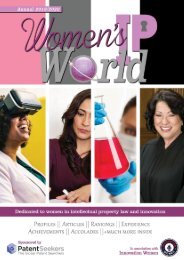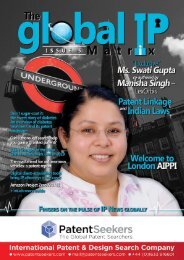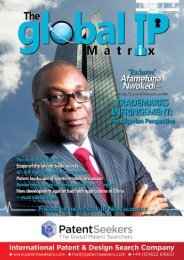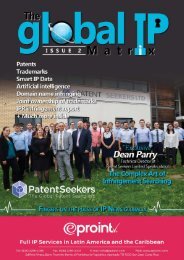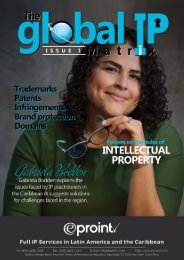Global IP Matrix - Issue 7
Dear readers, We sincerely hope that you are all in good health and keeping in good spirits during these undeniably uncertain times. We have all had to adapt to working out of our comfort zones, which I am sure has been very challenging at times for you all as it has been for us. However, we continue our quest to look to the future and deliver exclusive content to you, direct from thought leaders working at ground level in the IP industry from all over the world. Issue 7 of The Global IP Matrix magazine is packed with informative and exciting articles to keep you up to date and educated in what has been developing in the global IP industry during the past few months and into the future. We hope you enjoy reading our publication. We want to thank all our contributors for sharing their knowledge, opinions, and expertise in this new edition of the Global IP Matrix magazine. From all of us at The Global IP Matrix & Northon's Media, PR & Marketing Ltd
Dear readers,
We sincerely hope that you are all in good health and keeping in good spirits during these undeniably uncertain times. We have all had to adapt to working out of our comfort zones, which I am sure has been very challenging at times for you all as it has been for us.
However, we continue our quest to look to the future and deliver exclusive content to you, direct from thought leaders working at ground level in the IP industry from all over the world.
Issue 7 of The Global IP Matrix magazine is packed with informative and exciting articles to keep you up to date and educated in what has been developing in the global IP industry during the past few months and into the future. We hope you enjoy reading our publication.
We want to thank all our contributors for sharing their knowledge, opinions, and expertise in this new edition of the Global IP Matrix magazine.
From all of us at The Global IP Matrix & Northon's Media, PR & Marketing Ltd
Create successful ePaper yourself
Turn your PDF publications into a flip-book with our unique Google optimized e-Paper software.
TASTE & SMELL AS
TRADEMARKS IN NIGERIA:
panacea to the restraint of trade
Written by Ifeanyi Emmanuel Okonkwo,
Associate at Stillwaters Law Firm
www.stillwaterslaw.com
J. Varbanov & Partners
European and Bulgarian Patent & Trademark Attorneys
The Need
Trademark in Nigeria means a
mark used or proposed to be used
in relation to goods. A mark as
defined by the TradeMarks Act
(TMA) 1967 indicates ‘a device,
brand, heading, label, ticket,
name, signature, word, letter,
numeral, or any combination
thereof’. 1
One of the oldest and leading IP companies in Bulgaria
Professional, cost effective services and quality advices
Areas of practice:
*IP Protection
*IP Enforcement
*Anti-counterfeiting
*Litigations
*Domain name registrations
*IP watches
PO Box 1152, BG-1000 Sofia, Bulgaria
South Park Complex, bl.1A, 2nd fl., BG-1421, Sofia, Bulgaria
Tel.: (+359 2) 986 51 25, Fax: (+359 2) 980 32 47,
e-mail: jvp@jvpatents.com
www.jvpatents.com
But we know the sad realities of such
clauses – unless such a clause is in line with
public policy and is found to be reasonably
necessary, it is usually construed void when
tested in court. When the blue-pencil rule is
applied in interpreting such a restraint clause,
what is often left may not be enough to
protect the proprietors’ trade secrets. Besides,
the law protects the rights of every free citizen
to participate in trade. Truly, the restraint
of trade clause is not the best of methods.
The Trademarks Act essentially is there not
to restrain trade/traders, but to protect and
promote trade. It is an Act that protects the
right to use one’s invented trademark to the
exclusion of others. The owner of such a mark
could, of course, assign or licence another to
use the mark. The point is that the consumers
are not deceived into mistaking the origin
of the goods of the proprietor. That way, the
proprietor’s customers are protected, and
so are the proprietors’ goods, goodwill, and
accruable profits. Suppose then, the Nigerian
TMA defined a mark to include smell
and taste. The implication is that when an
employee leaves the employer’s company, that
employee cannot produce the same product
of the employer or a confusingly similar or
identical product. This is because the TMA
protects against the use of confusingly similar
marks. 2 Any such mark must be distinctive of
a registered mark.
The Problem
Now, apart from the fact that the Nigerian
Act did not define a mark to include taste and
smell, there is another problem. The problem
here is that a mark sought to be registered
has to be presented or placed in a graphical
manner. Such is the necessary interpretation
of regulation 23, 24, 25, and 30 of the
Trademarks Regulation (TMR). The problem
is not unknown to developed countries.
According to Cornish, Llewelyn, and Aplin: 3
‘Smell marks face even greater difficulties.
When the smell is the main object of the
product (as with scent or an air freshener), it
should not be capable of being a trademark
at all. Even when it is secondary additive
(detergent, shampoo, notepaper) it is
registrable only on very strong evidence of
recognition as a trademark, assuming that
in some way the applicant has complied with
the ‘graphical representation’ requirements
set out in Sieckmann (2003) RPC 38 EC J.’
While it is easy to represent such marks as
names, letters, numerals, even colour in
the space provided in Form 5, Some have
argued that it may be practically impossible
to represent a smell or taste in the space
provided and present the same online during
e-registration. Submitting in person, however,
may be much easier than through online
submission. This is because the product could
be glued to the space and covered. The same
can be said when the product is tasted. Now
the application makes it clear that what is
sought to be registered is not the product but
the smell or taste. Truly, sounds, smells, taste,
and touch have been successfully recorded
and registered in the foreign practice of
trademarks. Accordingly, Lea and Cornford 4
assures us:
‘Smell marks are recorded both as having
been registered, such as ‘the smell of freshcut
grass’ for tennis balls, and as having
been refused registration, such as the ‘smell,
aroma, or essence of cinnamon’ in relation to
furniture…However, the ECJ in Sieckmann,
while confirming that smells may act as
distinctive signs, appears to have rejected all
current practical methods of representing
them graphically.’
12 www.gipmatrix.com www.gipmatrix.com
13







